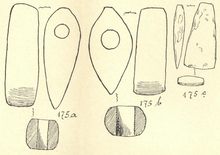Great stone grave Sallenthin
The large stone grave Sallenthin (also known as a six-week bed or six- week-old woman ) was a megalithic grave complex of the Neolithic deep-engraving ceramic culture near Sallenthin , a district of Kalbe (Milde) in the Altmark district of Salzwedel , Saxony-Anhalt . The grave was destroyed in the 19th century.
location
The grave was right on the border between Sallenthin and Quadendambeck .
Research history
The facility was first documented in the 1830s by Johann Friedrich Danneil , who only left handwritten notes about it. When the great stone graves of the Altmark were taken up again in the 1890s , Eduard Krause and Otto Schoetensack discovered that the grave had since been completely removed in the course of the separation .
description
The grave had a north-west-south-east oriented enclosure with a length of 28 to 32 m and a width of 6 m. Their shape was unusual for the large stone graves in the Altmark: it was rectangular on the northwestern half, but from the middle the rows of stones converged and collided at a point at the southeastern end. The burial chamber was apparently also oriented northwest-southeast and rectangular. It had a length of 7.2 m, a width of 1.9 m and a height of about 1.25 m. The wall stones were very close together; their insides were very flat. Danneil could see three fallen capstones. He also stated that the interior of the chamber was divided into four sections. Krause and Schoetensack, on the other hand, assumed that it was a matter of three further, vertically fallen cap stones, which Danneil misinterpreted as partitions. The grave should be addressed as a large dolmen .
Finds
Around the time of Danneil's admission, an excavation was carried out in the facility, but it remained unsuccessful. Nevertheless, the Johann Friedrich Danneil Museum in Salzwedel is in possession of three items that are said to have come from a large stone grave near Sallenthin. It is unclear whether they come from a later excavation at this facility or a neighboring one that has not been documented anywhere.
The found objects are two axes and a hatchet . The first ax is made of greenish-gray limestone . It has a length of 12.1 cm, a maximum width of 4.3 cm and a thickness of 3.5 cm. The bore has a diameter of 1.9 cm.
The second ax is made of greenish-gray serpentine rock. It has a length of 10.5 cm, a maximum width of 5.4 cm and a thickness of 3.9 cm. The bore has a diameter of 2.4 cm.
The ax is made of dark gray flint, ground on all sides . The cutting edge is slightly damaged. It has a length of 7.9 cm, a maximum width of 4.3 cm, a minimum width of 1.9 cm and a thickness of 1.3 cm.
The grave in regional sagas
According to a legend, the giant bed was built for a huge woman. The term “six weeks bed” or “six weeks mother” was derived from this. The burial chamber should represent the cradle.
literature
- Hans-Jürgen Beier : The megalithic, submegalithic and pseudomegalithic buildings and the menhirs between the Baltic Sea and the Thuringian Forest (= contributions to the prehistory and early history of Central Europe. Volume 1). Wilkau-Haßlau 1991, p. 58.
- Eduard Krause , Otto Schoetensack : The megalithic graves (stone chamber graves) of Germany. I. Altmark. In: Journal of Ethnology. Volume 25, 1893, No. 175 ( PDF; 39.0 MB ).
- Alfred Pohlmann : Legends from the cradle of Prussia and the German Empire, the Altmark. Franzen & Große, Stendal 1901, pp. 85–86.
